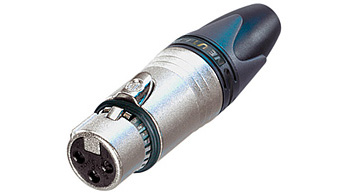Some Cabling Solutions to Reduce Power Line Noise in Audio
When two pieces of audio gear are connected together, an output of one to the input of the other, with the cable shield connected at both ends, a loop path is formed with the shield, equipment chassis, and safety ground of the power line.
If any noise is induced on the ground wire, this “ground loop” path can allow it to enter the audio circuitry. Good equipment design, like paying attention to the Pin 1 Problem, can go a long way to prevent this.
Often we need to work with what we have and an external solution is called for.

Neutrik EMC-XLR No matter how annoying any power line noise may be in the audio, DO NOT disconnect the safety ground to try to eliminate noise. The safety ground is there for a reason, to protect against fire, shock or electrocution should an equipment fault occur.
A good approach is to interrupt the ground loop by connecting the shield at only one end of the interconnecting cable. This is useful for analog audio line level connections (not microphone connections).
Those that have studied this problem suggest connecting the shield at the send end to get the best noise rejection at the interface.
But there is a tradeoff. This scheme can leave the receive end more vulnerable to radio frequency interference, so additional measures may have to be taken.
One is to connect a capacitor between the cable shield and the chassis of the receive equipment. The value of the capacitor can be between 1 and 100 nF.
This effectively disconnects the shield at the receive side at audio frequencies, which is what we want, but provides a path to ground for RF interference.
Another solution is to use a Neutrik EMC-XLR Series connector at the receive end. This special XLR connector has the capacitor built-in. The capacitance is actually circular, between the cable shield and the connector shell. The connector also has a ferrite bead in series with the shield and pin 1 of the connector to provide electro-magnetic interference suppression.
The professional video industry's #1 source for news, trends and product and tech information. Sign up below.
